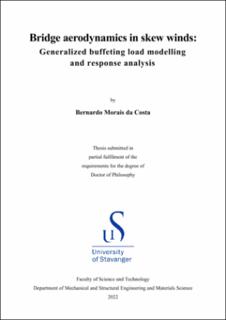| dc.contributor.advisor | Jakobsen, Jasna Bogunović | |
| dc.contributor.advisor | Wang, Jungao | |
| dc.contributor.author | Morais da Costa, Bernardo | |
| dc.date.accessioned | 2022-11-22T12:53:13Z | |
| dc.date.available | 2022-11-22T12:53:13Z | |
| dc.date.issued | 2022-11 | |
| dc.identifier.citation | Bridge aerodynamics in skew winds: Generalized buffeting load modelling and response analysis by Bernardo Morais da Costa, Stavanger : University of Stavanger, 2022 (PhD thesis UiS, no. 674) | en_US |
| dc.identifier.isbn | 978-82-8439-133-5 | |
| dc.identifier.issn | 1890-1387 | |
| dc.identifier.uri | https://hdl.handle.net/11250/3033416 | |
| dc.description | PhD thesis in Mechanical and Structural Engineering and Materials Science | en_US |
| dc.description.abstract | This thesis deals with the modelling of wind loads on bridges. When turbulent wind blows past a bridge deck, the deck experiences fluctuating loads, i.e., buffeting loads. Most buffeting theories concern straight bridge decks subjected to normal wind action, i.e., winds perpendicular to the bridge deck. This thesis initially reproduces the normal wind buffeting theory in a format that can be easily generalized to skew winds (i.e., non-perpendicular). The thesis then revises the state-of-the-art of the skew wind buffeting theory and proposes novel corrections, significant simplifications, and generalizations to that theory. Since the preferred skew wind load formulation requires the estimation of yaw- and inclination-angle-dependent aerodynamic coefficients, the thesis also provides a generalization and improvements to the traditional approach using only inclination-angle-dependent aerodynamic coefficients.
Multiple challenges arise when putting into practice the skew wind buffeting theory. An ongoing floating bridge project, whose details are described in the thesis, is considered an ideal case for this application. The long, curved, continuous and flexible structure is planned to span a record 5000 m wide section of the Bjørnafjord in Norway, where it will be subjected to strong winds from multiple directions.
Wind tunnel experiments were conducted by a third party, where a sectional model of the bridge girder was tested under skew winds for a large domain of yaw angles. Six aerodynamic coefficients are estimated for 30 combinations of yaw and inclination angles. Four different approaches to fit and extrapolate the coefficients are compared and discussed, enabling a 360-degree assessment of the skew wind buffeting response of the bridge. The proposed approach uses continuous and differentiable piecewise constrained bivariate polynomial functions covering the spherical domain of possible wind directions while respecting symmetries and imposing physical principles at certain angles.
A simplified numerical model of the bridge is developed, whose properties, assembling process, modal analysis and sensitivity results are presented in the thesis. The numerical model is then used to assess the novel and the traditional buffeting load formulations. The bridge displacement response is compared for different fits of the aerodynamic coefficients and for different buffeting and quasi-steady motion-dependent force formulations. Both frequency- and time-domain analyses are performed to increase confidence in the results. Methods that neglect the three-dimensionality of the wind-structure interaction and only consider the two-dimensional normal-plane projection of the wind are shown to underestimate the bridge response under skew winds.
The exceptionally long span of the case study makes it an equally good candidate for examining the wind field homogeneity assumption and its implications. A full long-term response analysis is performed considering all strong wind events in a 20-year-long wind field simulation period. Inhomogeneous (i.e., space-varying) wind speeds and directions were provided by a high-resolution Weather Research and Forecasting (WRF) model. Inhomogeneous wind turbulence intensities are estimated using a hybrid method combining formulations given in a European standard with an artificial neural network, trained with five years of relevant measurement data. An analogous database of equivalent homogeneous wind fields is created to compare the associated bridge responses. The long-term response is analysed, demonstrating a varying accuracy of the homogeneity assumption. On average, the bridge response under inhomogeneous winds is larger than that under homogeneous winds, but to a different extent for different response components. Large underestimations and overestimations of the response are obtained for particular wind events.
The use of a state-of-the-art skew wind formulation in combination with comprehensive wind tunnel tests and careful long-term inhomogeneous wind buffeting analyses is encouraged in the design of wind-sensitive bridges subjected to strong skew winds. | en_US |
| dc.language.iso | eng | en_US |
| dc.publisher | University of Stavanger, Norway | en_US |
| dc.relation.ispartofseries | PhD thesis UiS; | |
| dc.relation.ispartofseries | ;674 | |
| dc.rights | Copyright the author | |
| dc.rights | Navngivelse 4.0 Internasjonal | * |
| dc.rights.uri | http://creativecommons.org/licenses/by/4.0/deed.no | * |
| dc.subject | engineering | en_US |
| dc.subject | brobygging | en_US |
| dc.subject | aerodynamikk | en_US |
| dc.subject | bridge aerodynamic | en_US |
| dc.title | Bridge aerodynamics in skew winds: Generalized buffeting load modelling and response analysis | en_US |
| dc.type | Doctoral thesis | en_US |
| dc.rights.holder | ©2022 Bernardo Morais da Costa | en_US |
| dc.subject.nsi | VDP::Teknologi: 500 | en_US |

